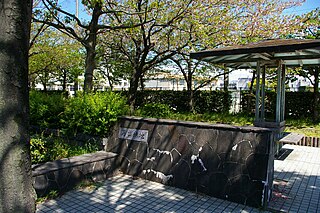 W
WMount Abura is a 597 m (1,959 ft) mountain located on the border of Minami-ku, Fukuoka, Sawara-ku, Fukuoka and Jonan-ku, Fukuoka, Fukuoka Prefecture, Japan. Mount Abura is the location where the Indian Buddhist priest Seiga produced the first camellia oil from seeds made in Japan during the Nara period. Abura means oil in Japanese.
 W
WGenkai Island is an island in Nishi-ku, Fukuoka, Japan. The island was seriously damaged by 2005 Fukuoka earthquake. The affected areas in the island were reconstructed by 2008.
 W
WHakata Bay is a bay in the northwestern part of Fukuoka city, on the Japanese island of Kyūshū. It faces the Tsushima Strait, and features beaches and a port, though parts of the bay have been reclaimed in the expansion of the city of Fukuoka. The bay is perhaps most famous for the Mongol invasions of Japan of 1274 and 1281 which took place nearby; both invasions are sometimes referred to as the "Battle of Hakata Bay."
 W
WIsland City (アイランドシティ) is artificial island in Hakata Bay, Fukuoka, Japan. Island Tower Sky Club and Teriha Sekisui House Arena are on this island.
 W
WMaidashi (馬出) is a district of Higashi-ku, Fukuoka, in Fukuoka Prefecture, Japan. It is divided into six chōme, numbered 1 to 6, with a total population of 8,813 and 5,341 households. The postal code for addresses in Maidashi is 812–0054. The "Maidashi" school district includes parts of the Higashi Hama district.
 W
WMaidashi Ryokuchi (馬出緑地) is an elevated linear park, greenway and rail trail in Higashi ward, Fukuoka, Japan. The park is located in Fukuoka's green belt, and is an example of the reuse of abandoned railway land in an urban setting. Nishi-Nippon Railroad sold the property to the city in 1980.
 W
WRakusui-en (楽水園) is a garden in Hakata-ku, Fukuoka, Japan. It was originally built in 1906 for Shimozawa Zenemon Chikamasa, a Hakata merchant. In 1995, Fukuoka City overhauled the structure and reopened it as a Japanese garden where visitors can experience a tea ceremony; with four tea rooms it is often used for tea ceremonies and related training.
 W
WShikanoshima Island is an island in Higashi-ku, Fukuoka, Japan. The island is known as the spot where the Gold Seal of the King of Na, a national treasure, was discovered. The island is about 11 kilometres around and connected to the Umi no Nakamichi (road) on the mainland by a causeway.
 W
WShōfū-en (松風園) is a Japanese garden attached to a former tea ceremony room in Chuo-ku, Fukuoka, Japan.
 W
WUmi no Nakamichi (海の中道) is a tombolo in Higashi-ku, Fukuoka, Fukuoka Prefecture, Japan. It connects Kyushu Island and Shikanoshima Island. It is 8km in length and up to 2.5 km in width. Its northern coast borders Genkai Sea and its southern coast Hakata Bay. There are many resorts. Most of the area is covered with sand hills but there is a terrace on the Northern side of the tombolo, where sands are believed to have been deposited during the Pleistocene.
 W
WYūsentei Park is a park in Jōnan-ku, Fukuoka, Japan. It was originally built in the mid-Edo period (1754) for Kuroda Tsugutaka, the 6th domain head of the Kuroda clan. It was named Yūsentei after a later lord's tanka poetry.